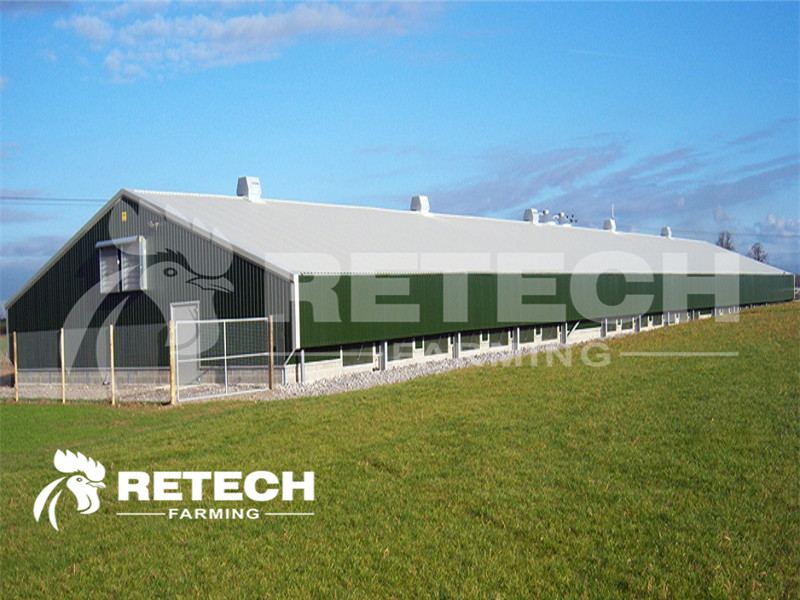Scientific Calculation Method of Ventilation Volume in Modernized Chicken House.
1.Determine the ventilation volume of the fan
The definition of fan air volume is: the product of wind speed V and air duct cross-sectional area F. Since large fans can accurately measure the air volume with [anemometer], the air volume calculation is also very simple, and the air volume can be calculated directly by using the formula Q=VF.
2.Determination of the number of fans
According to the ventilation frequency of the chicken house or the production requirements, calculate the total air volume required by the chicken house, and then calculate the number of fans.
Calculation formula: N=V ×n/Q, where: N–the number of fans (sets), V–site volume (m3), n–the number of air changes (times/hour), Q–the selected fan model The single typhoon volume (m3/h).

fans
3.Selection of fan model
According to the actual situation of the chicken house, try to select the fan model that matches the size of the original window, and try to keep a certain distance between the fan and the wet curtain (installed on both sides of the gable wall of the workshop as much as possible) to achieve good ventilation effect.
The exhaust side should be kept as close to nearby buildings as possible to avoid affecting nearby households.
4.The ventilation requirement of laying hens
The international calculation standard is based on the requirement of chickens per unit body weight. Big chickens are different from small chickens and cannot be simply calculated according to the number of chickens.
The minimum ventilation rate required for laying hens per kilogram of body weight is 0.4 to 0.9 cubic meters per hour;
The maximum ventilation rate required by laying hens per kilogram of body weight is 7.6 to 9 cubic meters per hour).
Chicken body temperature: temperature + humidity can not be higher than 102~104 (body temperature calculation: use a damp cloth to wrap the temperature probe, the displayed temperature is the chicken body temperature).
5.Calculate ventilation requirements
In the hot season, the air must be exchanged as soon as possible to reduce the heat accumulation.
If there is no air exchange, the heat will accumulate between the air intake and the exhaust fan, resulting in the increase of dust, ammonia, carbon dioxide and other harmful substances in the air.
Generally speaking, the ventilation system should have the ability to exchange all the air within 1 minute, and in warm seasons, the air exchange should be completed within 2 minutes;
36-inch fan rated negative pressure exhaust volume = 10000FPM;
The minimum ventilation rate of the chicken house: under the conditions that meet the conditions, the air exchange time of the entire volume of the chicken house is 5 minutes/time.

laying hens house
6.Appropriate temperature for laying hens
The most suitable temperature for chicken production and egg production is 18-25 °C, and a good production level can be achieved between 13-28 °C.
The temperature difference between day and night in the house is best controlled within 5 °C, and the maximum does not exceed 8 ℃, the temperature of the horizontal point in the house is controlled within 2℃, and the vertical temperature difference does not exceed 1℃.
At this time, it is necessary to adjust according to the change of the outside temperature, and gradually adjust the minimum temperature on the basis of the low temperature in winter. The house temperature in winter is generally controlled between 12-13 ℃. , in order to reduce the temperature difference between day and night in the house.
7.Requirements for the wind speed of the chicken house
The ventilation system should ensure that the minimum air velocity in the house is not less than 1 m/s, and the maximum air velocity is not more than 3 m/s.

modern chicken cage
8.Calculation of vent size
The air inlet required for a ventilation volume of 1 cubic meter per hour is 1 square centimeter, and when the air inlet mask is used as a hood, the area of the air inlet increases to 1.2 square centimeters.
The exhaust air volume of the chicken house is calculated according to 162,000 cubic meters per hour: the required air inlet = 162,000 cubic meters per hour × 1 square centimeters / 1 cubic meter per hour = 162,000 square centimeters = 16.2 square meters, when the negative pressure is correct, the ventilation system will It will work effectively and achieve the appropriate cooling effect.
9.The wind speed of the air inlet
In order to ensure ventilation efficiency and save energy, the speed of the air inlet should be lower than 5 m/s. If the air velocity of the air inlet is too fast, it can be solved by increasing the area of the air inlet.
10.The shape of the air inlet affects the distribution of the air in the house
In order for the air to be evenly distributed throughout the chicken house, the air must enter at a high velocity, so it should enter through some type of narrow inlet, called an air intake gap.
In most cases, it is best to make the air inlet almost the full length of the house to get enough ventilation, so in practice it is best to make the air inlet as thin as possible.
